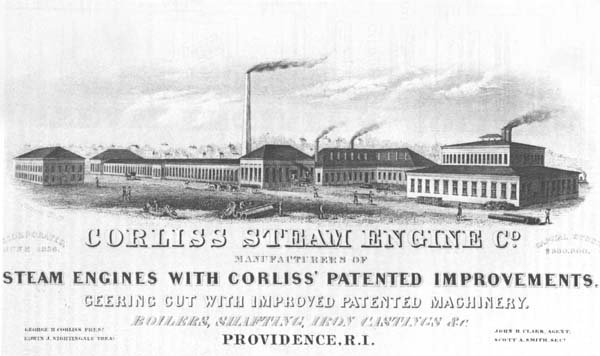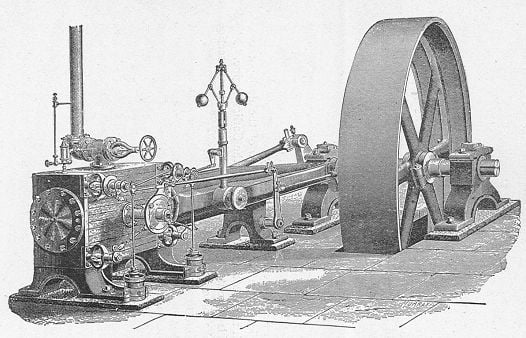For forty-four years George H. Corliss was a resident of Providence, where he invented and developed the steam engine that today is known throughout the civilized world by the name of its creator. He has been named as the man who did more for the development of the steam engine than any other individual in the history of the country. His fame was world-wide and his activities throughout his life were devoted to this one purpose. His loss to the commercial world was irreparable and language unequal to expressing the void that was created in inventive circles when he passed. He was of the seventh generation from the first of the name to set foot on American soil, the original ancestor having been George Corliss, who was born in Devonshire, England, in 1617, a son of Thomas Corliss, and came to New England in 1639, settling in Newbury, Massachusetts.
George H. Corliss was born in Easton, Washington County, New York, June 2, 1817, a son of Dr. Hiram and Susan (Sheldon) Corliss. He attended the village schools until he was fourteen years of age and then entered upon a business career as a clerk in a general store. Three years of this and he decided to attain further education and entered the academy at Castleton, Vermont. Early in 1838 he engaged in independent business as a merchant in Greenwich, New York. He was a natural engineer and his skill was illustrated when he was eighteen years of age by the planning and building of a temporary bridge across Batten Kill. His talents did not fully materialize, however, until he was twenty-four, when he began his real life work by inventing and manufacturing a machine for sewing heavy leather, boots and shoes. Although this machine was practical and useful, he lacked capital to put it on the market and finally abandoned it and entered upon a series of experiments looking toward the production of an improved steam engine. In 1844 he came to Providence and here entered into a partnership with John Barstow and E. J. Nightingale, under the firm name of Corliss, Nightingale and Company. In 1846 he began his development of the steam engine and by 1848 had completed and put into operation a machine that embodied the essential features of what later became known as the famous Corliss engine. In that year the plant of the present Corliss Steam Engine Company was begun and in 1849 he received important patents on his inventions. The Corliss Steam Engine Company was incorporated in 1856, with Mr. Corliss as president and his brother William as treasurer. As business grew the works were enlarged and at the time of his death the plant covered more than five acres of space and employed more than a thousand hands. The engine was exported to all parts of the world and was recognized as one of the most valuable mechanical appliances of a labor-saving era. At the Paris Exposition of 1867 he received the highest prize against a hundred competitors representing the best from all the engine builders of the world. J. Scott Russell, English engineer and builder of the steamship “Great Eastern,” was one of the British commissioners to that exposition and reported to his government on the Corliss engine: “A mechanism as beautiful as the human hand. . . . The American engine of Corliss everywhere tells of wise forethought, judicious proportions and execution and exquisite contrivance.” The Rumford medals were awarded Mr. Corliss January n, 1870, at which time Dr. Asa Gray, president of the Academy, paid a great tribute to the inventor, saying, among other things, that “the Academy rejoices when, as now, it can signalize an invention which unequivocally tends to promote that which the founder had most at heart, the material good of mankind. The inventor has shown conspicuously his mastery of the resources of mechanism.” This was just a century after Watt had presented his improvements on the then existing steam engine. The award of the Grand Diploma of Honor from the Vienna Exhibition in 1873 was another triumph for the inventor of this engine. Foreign builders had followed his designs and sent their engines to the exhibition with their names upon them and he was without representation of any sort. Hence, the jurors awarded the Diploma of Honor as “a particular distinction for eminent merits in the domain of science, its application to the education of the people and its conducement to the advancement of intellectual, moral and material welfare of man.” He was the only person to receive a diploma without being an exhibitor. The Institute of France, by public proclamation, bestowed on Mr. Corliss, March 10, 1879, the Montyon prize for the year 1878, this being the highest prize of the Old World for mechanical achievement.

In 1872 he was appointed a commissioner from the State of Rhode Island to take charge of the exhibit at the Centennial Exposition in Philadelphia, held in 1876, and was chosen one of the executive committee of seven entrusted with the preliminary work. It was at his suggestion that the Centennial Board of Finance was organized, which was a most important feature of insuring the financial success of the undertaking. The great Corliss engine was one of the wonders of the exhibition, developing 1,400 horse-power for the operating of Machinery Hall. This great machine was installed at a personal cost to Mr. Corliss of more than one hundred thousand dollars. After viewing it at work, Professor Radinger, of the Polytechnic School of Vienna, said of it: “Systematical in greatness, beautiful in form and without fault—in every detail a masterpiece.” The machine was afterward used in operating the Pullman car works at Pullman, Illinois. During the Civil War the Corliss works furnished machinery for the government and later Mr. Corliss developed his engine and adapted it for pumping water supplies for towns and cities. He also made improvements in boiler condensing apparatus for marine and pumping engines and invented a machine for cutting cogs of bevelled wheels. In politics he was a Republican and served in 1868-69 and 1870 as representative from North Providence to the Rhode Island General Assembly. In 1876 he was elected a Presidential elector from this State and cast his vote for Rutherford B. Hayes. He was a member of the Congregational Church and was liberal in his gifts to many religious organizations. His death took place February 21, 1888.

George H. Corliss married (first), in January, 1839, Phebe F. Frost, born in Canterbury, Connecticut, died in Providence, Rhode Island, March 5, 1859. He married (second), in December, 1866, Emily A. Shaw, born in Newburyport, Massachusetts. His two children born of the first marriage, were: 1. Maria Louisa, born December 13, 1839, died June 13, 1929. 2. George Frost, born in October, 1841, died September 7, 1927.
Among the great geniuses of American production, George H. Corliss will have high rank. Benefits to humanity that arise from invention and development mark their originator as deserving of the undying gratitude of civilization and this is the position in which he stood during his useful life and which he will hold forever in the pages of American history, while his fame will be equally deathless wherever man toils and uses mechanical appliances in his labors.
Source: Carroll, Charles. Rhode Island: Three Centuries of Democracy, vol 3 of 4. New York: Lewis historical Pub. Co., 1932.
